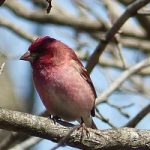At Winding Pathways, we venture into our yard nearly every day, even if it’s raining, windy,
or frigid out. Of all the times, early May is our favorite to linger outdoors. Why? It’s the best birding.
Very late April and the first couple of weeks of May boast normally glorious weather, blooming flowers and birds. Lots of birds, including those we can only enjoy for a fleeting week or two.
Here’s how we group the birds that we enjoy in our yard. Odds are the same or similar species follow this pattern in backyards with good habitat across much of the continent.
THE HOMEBODIES
Some birds don’t migrate. They brave the cold and grace winter feeders. In summer, they often raise broods of babies on the edge of the yard. These include titmice, chickadees, cardinals, nuthatches, house sparrows, and many woodpeckers.
THE NORTHERNER
Juncos are almost always under our feeders all winter gleaning seeds. To a Junco Iowa is the balmy south with a “warm” winter. Around mid-April they head north to nest in the boreal forests of Canada and Minnesota. We won’t see them again until around Halloween.
THE LOCALS
Many people consider the first sighting of a Robin to be a sign of spring. They assume the birds just arrived from the south. Robins, and closely related bluebirds, aren’t ambitious migrants. As the weather cools each fall, they abandon suburbia and move to nearby brushy areas for the winter. Winter Robins are common in orchards, the edges of farm fields, and wherever they can find dry and frozen fruit. These much-admired birds do a dietary switcheroo each year. Robins are famed worm eaters, and during warm months, they mostly eat insects and other invertebrates. In winter, they’re mostly vegetarians and dine on frozen berries. In years when fruit is scarce they’ll move south until they find suitable foraging.
THE HOMESTEADERS
Many birds are true migrants that winter far to the south but return north to raise a family. Among these true migrants are house wrens, rose breasted grosbeaks, orioles and indigo buntings. The homesteaders that nest at Winding Pathways have reached their northernmost destination but many of the same species simply rest and eat for a day or two before flying further north to nest. They are mere passersby.
THE AMBITIOUS MIGRANTS
Many birds are serious migrants that winter in South or Central America or the southern US and wing north to Canada and even Alaska to nest, only stopping to rest and eat for a day or two on their long journey. Many are warblers, although dozens of other bird species only use Winding Pathways as their “quick stop” on the way north. We can only enjoy the procession for a week or two in early May as the migrants stock up and then catch the next southerly winds to propel them to their nesting areas.
BIRDING AT ITS BEST
What’s remarkable about early May is the sheer diversity of birds that visit yards. It’s the best time to bring a cup of coffee and pair of binoculars outside. Sit quietly and look and listen to discover the amazing array of birds not possible observe in other seasons. A good bird book helps with identification but we often use the resources of the Cornell University Laboratory of Ornithology to help us identify and learn about birds. Their website at includes outstanding information that helps us determine species by both sight and sound and we frequently use their MERLIN phone app when we’re hiking or camping.


